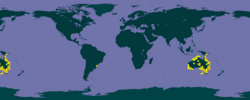Biology:Panus fasciatus
| Panus fasciatus | |
|---|---|

| |
| Scientific classification | |
| Domain: | Eukaryota |
| Kingdom: | Fungi |
| Division: | Basidiomycota |
| Class: | Agaricomycetes |
| Order: | Polyporales |
| Family: | Panaceae |
| Genus: | Panus |
| Species: | P. fasciatus
|
| Binomial name | |
| Panus fasciatus (Berk.) Pegler[1]
| |

| |
| Species distribution of Panus fasciatus | |
| Synonyms[1] | |
|
Lentinus fasciatus Berk. | |
Panus fasciatus (common name includes hairy trumpet) is a species of fungus in the family Polyporaceae in the genus Panus of the Basidiomycota. [1] P. fasciatus has a fruiting body in the shape of a funnel with a velvety texture, hence the nickname "hairy trumpet." When it was identified by D. Pegler of Kew, [2] he created a subgroup of the Lentinus fungi, called Panus based on their hyphal systems. [3] For this reason, Panus fasciatus is sometimes referred to as Lentinus fasciatus. [1] Panus fasciatus has been described with numerous other names which were combined by Pegler in 1965. [4]
Morphology
The fungus has a unique shape, with the cap in-rolled when the fungus is young, and then developing a funnel (or infundibuliform) shape over time.[5] It is also known for having pale brown hairs that cover the cap. [6] In dry conditions, the stalk peels like bark but returns to normal following rain.[5] P. fasciatus also has deeply decurrent gills, a velvety pileus, and dense hairs. [7] The fungus can have purple gills that turn brown as they mature. [5] The spores have a white print. [6]
Reproduction
Basidiospores of P. fasciatus reside on the hymenium of the gills of the fruiting body.[8] When two germinating basidiospores of opposite mating types fuse via plasmogamy, the two nuclei remain unfused while a basidiocarp fruiting body is formed. [8] On the gills beneath the cap, numerous basidia are formed. [8] Karyogamy and meiosis occur and give rise to mature basidiospores.[8] These are then released via the Buller's drop method of spore dispersal. [8]
Ecology
Panus fasciatus is a wood-decaying saprotroph that feeds on rotting logs or small branches.[9]
Habitat
Panus fasciatus is commonly found in drier woodland environments, amongst the grass, and beneath eucalypts, acacias, and casuarinas. [5] It is usually exposed to sunlight most of the day.[5]
Distribution
Panus fasciatus has been recorded in southern and eastern Australia, Africa, Cameroon,[10] Oceania, Papua New Guinea, and New Caledonia, however, much of its distribution is unknown.[7] It has been recorded in low numbers in the Jarrah forest region of western Australia.[11]
Taxonomy
The species was originally described by Miles J. Berkeley in 1840 as Lentinus fasciatus. [12] It was later renamed by David Pegler of the Kew Royal Botanical Garden in 1965 in the Australian Journal of Botany. [1] Pegler treated Panus as a subgroup of Lentinus, however another mycologist, Corner, considered Panus and Lentinus as two separate genre based on their hyphal systems, so their relationship is controversial. [3] These subgroups were identified based on morphology, but held true for the most part upon more molecular research. [13] Pegler's identification of P. fasciatus was based on collections from Tasmania gathered by R.C. Dunn and R. W. Lawrence. [12] P. fasciatus was among the first fungal species to be identified in Australia. [12]
| Panus fasciatus | |
|---|---|
| Mycological characteristics | |
| gills on hymenium | |
| cap is infundibuliform | |
| hymenium is decurrent | |
| stipe is bare | |
| spore print is white | |
| ecology is saprotrophic | |
| edibility: unknown | |
References
- ↑ 1.0 1.1 1.2 1.3 1.4 "Index Fungorum - Names Record". http://www.indexfungorum.org/names/NamesRecord.asp?RecordID=441018.
- ↑ Jardine, Nicholas (2008). Pegler, David; Freedberg, David. eds. "Prince Cesi and Fungi, Not to Mention Fungifunguli". The British Journal for the History of Science 41 (2): 267–273. doi:10.1017/S0007087408001258. ISSN 0007-0874. https://www.jstor.org/stable/30165693.
- ↑ 3.0 3.1 Senthilarasu, Gunasekaran (June 2015). "The lentinoid fungi (Lentinus and Panus) from Western Ghats, India". IMA Fungus 6 (1): 119–128. doi:10.5598/imafungus.2015.06.01.06. ISSN 2210-6340. PMID 26203417.
- ↑ May, Tom W. (2003-02-04). "The status of names and records of Australian macrofungi" (in en). New Zealand Journal of Botany 41 (3): 379–389. doi:10.1080/0028825X.2003.9512857. ISSN 0028-825X. http://www.tandfonline.com/doi/abs/10.1080/0028825X.2003.9512857.
- ↑ 5.0 5.1 5.2 5.3 5.4 Robinson, Richard. "Panus fasciatus hairy trumpet". https://www.dpaw.wa.gov.au/images/documents/about/science/fungus/25_2008-09_Panus_fasciatus_DEC_FF.pdf.
- ↑ 6.0 6.1 Australia, Atlas of Living. "Species: Panus fasciatus" (in en-AU). https://bie.ala.org.au/species/38bdf5e0-024d-4d22-b049-af4f14d7eb77.
- ↑ 7.0 7.1 Niouonkou, A (2013). "The genera Lentinus and Panus in the Dja Biosphere Reserve and its periphery, Cameroon". Kew Bulletin 68 (3): 517–521. doi:10.1007/s12225-013-9461-1. https://link.springer.com/article/10.1007/s12225-013-9461-1.
- ↑ 8.0 8.1 8.2 8.3 8.4 Webster, John; Weber, Roland (2007), "Introduction", Introduction to Fungi (Cambridge: Cambridge University Press): pp. 1–39, doi:10.1017/cbo9780511809026.004, ISBN 9780521014830, http://dx.doi.org/10.1017/cbo9780511809026.004, retrieved 2022-05-05
- ↑ Broughton, H (1972). "The fungus Panus fasciatus (Pleurotaceae) characterised by microstructure of sporophore and culture". Journal of the Royal Society of Western Australia 55: 31–38. https://biostor.org/reference/226112.
- ↑ Douanla-Meli, Clovis; Ryvarden, Leif; Langer, Ewald (2007-05-01). "Studies of tropical African pore fungi (Basidiomycota, Aphyllophorales): three new species from Cameroon". Nova Hedwigia 84 (3–4): 409–420. doi:10.1127/0029-5035/2007/0084-0409. ISSN 0029-5035. http://dx.doi.org/10.1127/0029-5035/2007/0084-0409.
- ↑ Robinson, Robert (June 2016). "Department of Parks and Wildlife Science & Conservation Division FOREST CHECK REPORT OF PROGRESS 2014". Parks and Wildlife: 36. https://www.dpaw.wa.gov.au/images/documents/about/science/pubs/reports/forestcheck/fc_progress_report_sandy_basins_2014.pdf.
- ↑ 12.0 12.1 12.2 History of systematic botany in Australasia : proceedings of a symposium held at the University of Melbourne, 25-27 May 1988. P. S. Short. South Yarra, Vic.: Australian Systematic Botany Society. 1990. ISBN 0-7316-8463-X. OCLC 22771415. https://www.worldcat.org/oclc/22771415.
- ↑ Zmitrovich, Ivan V.; Kovalenko, Alexander E. (2016). "Lentinoid and Polyporoid Fungi, Two Generic Conglomerates Containing Important Medicinal Mushrooms in Molecular Perspective" (in en). International Journal of Medicinal Mushrooms 18 (1): 23–38. doi:10.1615/IntJMedMushrooms.v18.i1.40. ISSN 1521-9437. PMID 27279442. http://www.dl.begellhouse.com/journals/708ae68d64b17c52,33df00905b660ea5,4e1b486f73b7dad7.html.
Wikidata ☰ Q105060111 entry
 |

